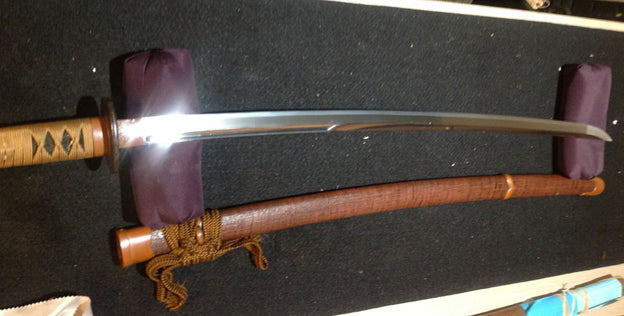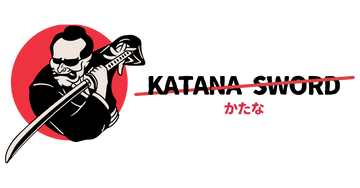Japanese swords are some of the world’s most iconic bladed weapons. From the curved Tachi to the legendary Katana, these swords are not only deadly tools but also mesmerizing works of art.
Unfortunately, the Samurai’s demise in the Meiji era saw these weapons take a backseat to the deadlier rifle. However, the Second World War saw Japanese military officers wielding swords. What happened? Join us in exploring the resurgence of the Japanese sword, including the Japanese sword used in WW2.
Understanding World War II Japanese Swords
Appreciating WW2 Japanese swords starts with a brush-up of history. We will begin with the Meiji Period.
This period in Japanese history marks the nation’s pursuit of social, political, and economic reforms. It opened Japan to Western customs and technologies, allowing the country to move from its feudal system to modernity.
Historians say the Meiji Period laid the foundation for Japan’s rise in the international scene as a major power.
The reforms required the Japanese to ditch the old ways and embrace the new, including forgetting the sword as a quintessential tool of destruction. The Haitorei edict made carrying and displaying of swords (especially katanas) in public illegal. It was a bitter people many Japanese found difficult to swallow.

The Meiji Period of Japanese restoration, reformation, and modernization. Photo by The Japan Times.
Although Japan’s march to the modern era prompted a review of its military capabilities, some in the top brass drew from age-old traditions for inspiration. While the Katana is no match for a 20th-century rifle, the Japanese sword holds a special place in the nation’s identity.
Hence, the ever-expanding Imperial Japanese military sought to differentiate its officers from the ordinary infantrymen and sailors. There’s only one answer to this – the sword. Japanese military leaders might have varying opinions, but they share one attribute – they must all carry a Japanese sword.
Unfortunately, Japan’s growing military posed several concerns about its sword-making capabilities.
Demand Exceeds Supply
Traditional Katana-kaji (swordsmiths) take many months to forge a single katana. And although many swordsmithing schools existed throughout Japan in the early 20th century, the unusually long forging process meant they could only churn out a few swords at a time.
Bladesmiths could not keep up with the growing number of Japanese military officers requiring swords.
Compromised Sword Quality
Meeting the demand for officers’ swords was necessary for the Imperial Japanese military’s goals. Hence, they employed other bladesmiths to make Japanese swords. Although these craftspeople also forged bladed tools, their knowledge and skills in making swords are questionable.
Machine-produced vs. Traditional Hand-forged
Forging a Japanese sword by hand takes many weeks up to months. For a growing military, a more efficient sword-making system is necessary. Hence, most Japanese military officers (especially lower to middle ranks) used machine-produced swords.
High-ranking officials opted for traditional hand-forged swords. For example, the Pearl Harbor and Midway brains, Admiral Isoroku Yamamoto, carried the Amada Sadayoshi Gensui katana.
Japanese Swords Used in the Second World War
Japanese military leaders in the Second World War carried one of two general classes of swords – Kyu Gunto and Shin Gunto.
Kyu Gunto
“Old military sword” is how many translate Kyu Gunto. These bladed weapons used by Japanese military leaders in World War II were produced between 1875 and 1934.
Because Japan also went to war with China (1894 to 1895) and Russia (1904 to 1905), many historians call Kyu Gunto Sino-Japanese War swords and Russo-Japanese War swords, respectively.
The Murata-to is the quintessential Kyu Gunto Japanese sword used in World War II.
Murata-to
Few resources exist about the origins of this legendary Japanese sword used in WW2, except it was the brainchild of Imperial Japanese Army Infantry Major General Murata Tsuneyoshi, who was also a Danshaku or a member of the Japanese Nobility.
Murata studied modern gunnery techniques and firearms technology in France, Norway, Sweden, Germany, and the Netherlands in 1875. He used his knowledge to develop Japan’s first locally-produced service rifle – the Murata.
During experimentation with different metals for rifle components, Murata extended the tests to various sword metals. Although nobody could pinpoint the precise metallurgical characteristics of the resulting Murata-to (Murata sword), swordspeople noted how Murata’s sword creation was better than Masamune’s or Muramasa’s.
The Murata-to was lighter than European blades, yet it cuts and slashes better. However, the first Murata-to was still too heavy for the average Japanese officer.
Later developments would see the sword slightly lighter, making the Murata-to a must-wear for Imperial Japanese military officers.
Unfortunately, the metal mix strayed far from the traditional Tamahagane steel katanas revered in feudal Japan. Hence, many sword purists do not consider the Murata-to a “true” Japanese sword.

A Murata-to Japanese sword used in WW2. Photo by Jim Manley.
Although the Murata-to was emblematic of pre-WW2 Japanese swords, individual blades varied greatly.
Producers only created swords in small batches, often not exceeding 25 swords, to maintain as much of the legacy of the Japanese sword culture as possible. Some forged blades according to military ranks, while others hinged on wealth.
Many Murata-to drew inspiration from feudal Japanese swords, while others featured familial crests and symbols. Some Murata-to embedded artistic elements, including European-style cloisonné, silverworks, paint, metal works, and jade.
It is worth noting that Kyu Gunto was unlike the legendary hand-forged Katanas of feudal Japan. Its style is like American and European dress swords with a less pronounced Sori (curve) than the traditional Katana. The Saya (sword sheath) featured chrome plating, and steel became the preferred Saya material in the 1900s.
The most glaring difference is the hand guard. The traditional Katana has a disc-shaped Tsuba, while the Kyu Gunto features a D-guard (like Western swords).
Although Kyu Gunto are pre-WW2 swords, many Japanese Imperial military officers (mostly high-ranking officials) still used them during the Second World War.
Shin Gunto
Japanese swords forged within ten years after 1935 are Shin Gunto or “new military swords.” If Kyu Gunto had more European and American influences in their style, Shin Gunto swords highlighted the return to Kamakura Period-style Tachi (the katana’s direct predecessor). Hence, the Sori (curve) was more pronounced, and the Nagasa (blade) was longer than the katana.
The “return-to-roots” change in sword-making philosophy describes the Japanese Imperial Armed Forces’ growing nationalism. Their conquests over the Chinese and Russians at the turn of the century emboldened the Japanese military.
Like Kyu Gunto swords, Shin Gunto had different styles depicting military ranks. For example, Imperial Japanese generals had Shin Gunto with gold and brown-red tassels, while field officers (i.e., colonels and majors) had brown and red-tasseled Shin Gunto.
Warrant officers and company officers (captains and lieutenants) had brown and blue tassels, while non-commissioned officers (sergeants and corporals) had brown tassels.
The Toyokawa Naval Arsenal in present-day Aichi Prefecture produced most Shin Gunto swords that would see action in the Second World War. Four Shin Gunto sword types were common when WW2 broke out.
Type 94 – Kyuyon-shiki
The Kyuyon-shiki Gunto or Type 94 replaced the Kyu Gunto in 1934. It was a radical jump from the previous Japanese sword because it ditched the mostly-Western design elements for more nationalistic symbols.
The Type 94 was reminiscent of Samurai katanas, except for more artistic and exquisite elements. For example, the Tsuka (hilt or handle) featured a combination of traditional silk and ray skin wrapping.
Sword designers removed the Kyu Gunto’s D-guard and returned the iconic katana disc-shaped Tsuba, except it now featured the cherry blossom. The Japanese flower also adorned the Kyuyon-shiki’s pommels (Kashira and Fuchi) and other sword ornaments (Menuki).
Although most pre-WW2 Japanese swords had steel Saya (sheaths), the Type 94 featured a wood interior lining to protect the Nagasa. Moreover, the Saya had two brass mounts and was painted brown to make it look like a traditional wooden Saya. Cherry blossom designs adorned the sheath fittings.

A Kyuyon-shiki (Type 94) Japanese sword used in WW2. Photo by St. Croix Blades.
Type 95 – Kyugo-shiki
Only non-commissioned officers of the Imperial Japanese Army used the Kyugo-shiki in World War II. One can distinguish the Type 95 from the Type 94 by its deep Bohi (fuller) and Arabic numeral serials on the Nagasa.
Released in 1935, Kyugo-shiki swords had machine-made blades, although they still resembled an Imperial Japanese military officer’s sword. Japanese sword manufacturers at the time incorporated a brass Tsuba and aluminum or copper Tsuka (hilt) into the Type 95 to make it look identical to the Type 94.

A Kyugo-shiki (Type 95) Japanese sword for NCOs. Photo by Boonie Stomper.
Type 98 – Kyuhachi-shiki
Four years after the Type 94’s release, Japanese swordsmakers introduced the Kyuhachi-shiki. The early Type 98 version was nearly identical to the Type 94, except for a missing scabbard mounting point.
From 1938 to 1945, the Kyuhachi-shiki underwent several transformations. These changes had nothing to do with a change in Japanese sword-making philosophy but more with dwindling resources as WW2 reached its climax.
Later Type 98 models featured wooden Saya, but still painted brown. Brass ornaments were either toned down or ditched altogether. Blackened iron components and cheap copper fittings also featured prominently in later models.

A Kyuhachi-shiki (Type 98) Japanese sword. Photo by Epic Artifacts.
Kaigunto
Type 94, 95, and 98 Shin Gunto are for the Imperial Japanese Army. The Shin Gunto of naval officers was the Kaigunto. Unlike their Army counterparts, Imperial Japanese Navy officers carried more elegant swords, including a dark blue or black-lacquered Saya with a ray skin wrapping.
Most Kaigunto swords originated from the Tenshozan Tanrenjo, although some would also come from the Toyokawa Naval Arsenal.

A Kaigunto for the Japanese Naval Officer. Photo by the Australian War Memorial.
The Bottom Line
A Japanese sword used in WW2 was more ceremonial (or ornamental) than a legendary slasher (unlike the mythical katana of feudal Japan). Displaying these swords in Japan is illegal because the government does not recognize them as “true” Japanese swords. However, the rest of the world loves these bladed tools as “invaluable collectors’ items.”

























